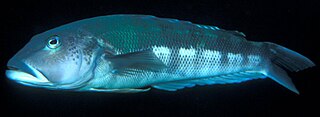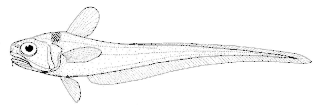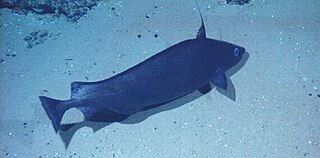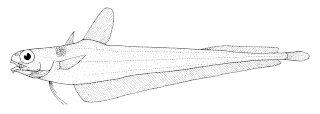
Arctogadus glacialis, known also with ambiguous common names Arctic cod and polar cod, is an Arctic species of fish in the cod family Gadidae, related to the true cod. Arctogadus glacialis is found in icy water. They grow to about 30 cm long, and are favorite food of narwhals and other arctic whales.

The small-headed cod or the long-finned cod is a deepwater fish belonging to the morid cod family (Moridae), and related to the true cods. It is found in the Tasman Sea, including the Bass Strait. It is commercially harvested by both Australia and New Zealand. It has been found on the continental shelf, but typically its depth range is from 750 to 1,000 m. It grows to 48 centimetres (19 in) in total length.

The New Zealand blue cod is a temperate marine fish of the family Pinguipedidae. It is also known variously as Boston blue cod, New Zealand cod, sand perch, or its Māori names rāwaru, pākirikiri and patutuki.

Sprat is the common name applied to a group of forage fish belonging to the genus Sprattus in the family Clupeidae. The term also is applied to a number of other small sprat-like forage fish. Like most forage fishes, sprats are highly active, small, oily fish. They travel in large schools with other fish and swim continuously throughout the day.
The pink cusk-eel, Genypterus blacodes, is a demersal species of cusk-eel found in the oceans around southern Australia, Chile, Brazil, and around New Zealand except the east coast of Northland, in depths of 22 to 1,000 metres. Their length is up to 200 centimetres, and they live for up to 30 years. Their maximum weight is 25 kilograms.

The ahuru is a species of morid cod found in waters off the eastern coast of New Zealand and to the south as well as in the Cook Strait. It is found at depths from 5 to 420 m. This species grows to 13 cm (5.1 in) in total length. It is the only known species of its genus.

The hāpuku, hapuka or whapuku, also known as groper, is a wreckfish of the family Polyprionidae, found around southern Australia, southern South America, South Africa, Tristan da Cunha and New Zealand at depths between 30 and 800 m. Its length is between 60 and 180 cm, and it can weigh up to 100 kg. It is sometimes described locally as cod, although that properly refers to other fish. This fish fears the anglers off the Albany coast.

The thorntooth grenadier or javelin fish, Lepidorhynchus denticulatus, is a rattail, the only member of the genus Lepidorhynchus, found around southern Australia and New Zealand, at depths of between 200 and 1,000 m. Its length is between 20 and 55 cm.
The codheaded rattail, Bathygadus cottoides, is a rattail of the genus Bathygadus, found in the southeast Atlantic Ocean and the southwest Pacific Oceans, at depths of between 1,000 and 1,600 m. Its length is between 20 and 30 cm.
The blue grenadier is a merluccid hake of the family Merlucciidae found around southern Australia and New Zealand, as well as off both the Atlantic and Pacific coasts of South America from Peru to Brazil at depths of between 10 and 1,000 m. It feeds in midwater on small squids, crustaceans, and fish. Its length is between 60 and 120 cm. It is a slender, silvery fish similar in appearance to the gemfish. The meat of the fish is white and almost always sold in fillets; culinarily it is considered a whitefish.

The blue antimora, also known as the flat-nose codling, blue hake, long-finned cod or violet cod, is a benthopelagic species of morid cod of the genus Antimora, found in seas around the world on the continental shelf except the north Pacific. This bluish-black species may be found at depths of between 350 and 3,000 m(1,148 to 9.843 ft) ,but it is commonly found at depths of 800-1800m. Its length is between 40 and 75 cm. It is of minor importance to commercial fisheries.
The slender codling or slender cod is a morid cod, the only species in the genus Halargyreus. It is found in all oceans, at depths from 450 to 3,000 m, and grows to 56 cm (22 in) in total length. First discovered by and named after James Yate Johnson.

The oilfish is a species of snake mackerel fish with a cosmopolitan distribution in tropical and temperate oceans. It can be found at depths of from 100 to 800 metres, usually between 200 to 400 metres. It can grow to a length of 300 centimetres (120 in) TL though most do not exceed 150 centimetres (59 in) SL. The maximum recorded weight is 63.5 kilograms (140 lb). It is currently the only known member of its genus.

The southern blue whiting is a codfish of the genus Micromesistius, found in the southern oceans with temperatures between 3 and 7 °C, at depths of 50 to 900 m. Its length is commonly between 30 and 60 cm, with a maximum length of 90 cm. Maximum weight is at least 1350 g.

The southern bastard codling or bearded red cod is a morid cod of the genus Pseudophycis, found around southern Australia including Tasmania, and New Zealand, from the surface to 300 m. Its length is up to 63 cm.

The red codling or hoka is a morid cod of the genus Pseudophycis, found around southern Australia and New Zealand, from the surface to 700 m. Its length is up to 90 cm. P. bachus is a food source for the diving yellow-eyed penguin, Megadyptes antipodes.

The red gurnard perch or jock stewart, Helicolenus percoides, is a rockfish of the family Sebastidae, found on the continental shelves of Australia and New Zealand at depths of between 20 and 750 m. Its length is up to 47 cm. Also called Ocean Perch, Coral Cod, Coral Perch, Reef Ocean Perch, Red Perch, Red Rock Perch, Red Gurnard Scorpionfish, and Sea Perch.

The saddletail grouper, also known as black cod or black rock-cod in Australia, and as saddle-tailed grouper or spotted black grouper in New Zealand, is a large marine fish of the family Serranidae. It is found off the coastline of southeastern Australia and northern New Zealand, generally inhabiting near-shore rock and coral reefs at depths down to 50 metres. Its main range comprises the southeast coastline of Australia, in the state of New South Wales; New Zealand populations are suspected to be nonbreeding, so are a result of drifting larvae. However, spawning aggregations have been recorded off northern New Zealand.

The Maori cod, also known as Magellanic rockcod, blue notothenia or orange throat notothen, is a species of notothen native to the Southern Ocean. "Maori chief" and "black cod", sometimes used for this species, usually refer to fishes from the related genus Notothenia. It occurs at depths from near the surface to 255 m (837 ft), though it is usually found at less than 20 m (66 ft). This species can reach a standard length of 38 cm (15 in). Being a perciform fish, it is unrelated to the true cods of the order Gadiformes. This species is commercially important as a food fish.

Tripterophycis is a genus of morid cods.
















